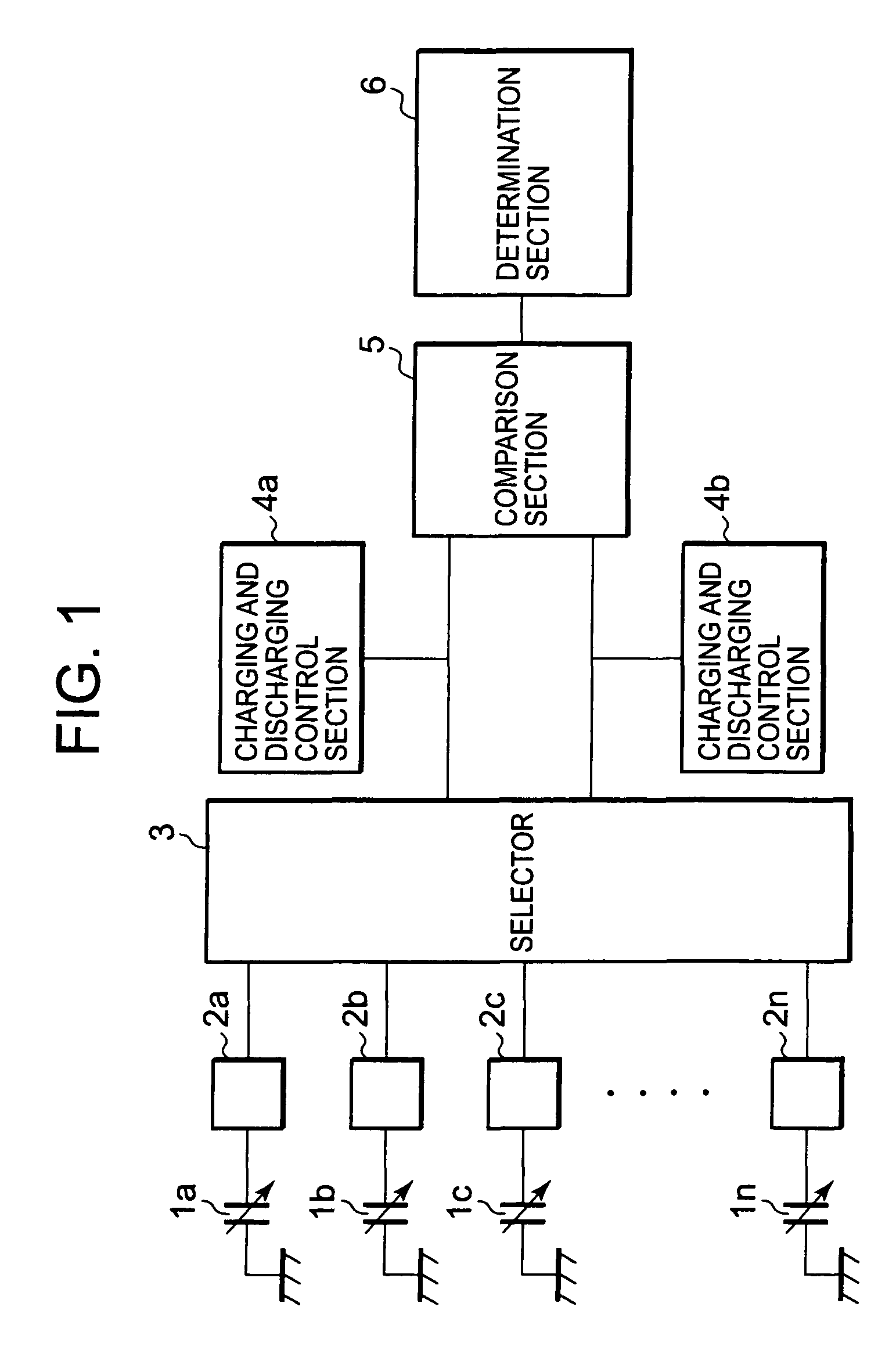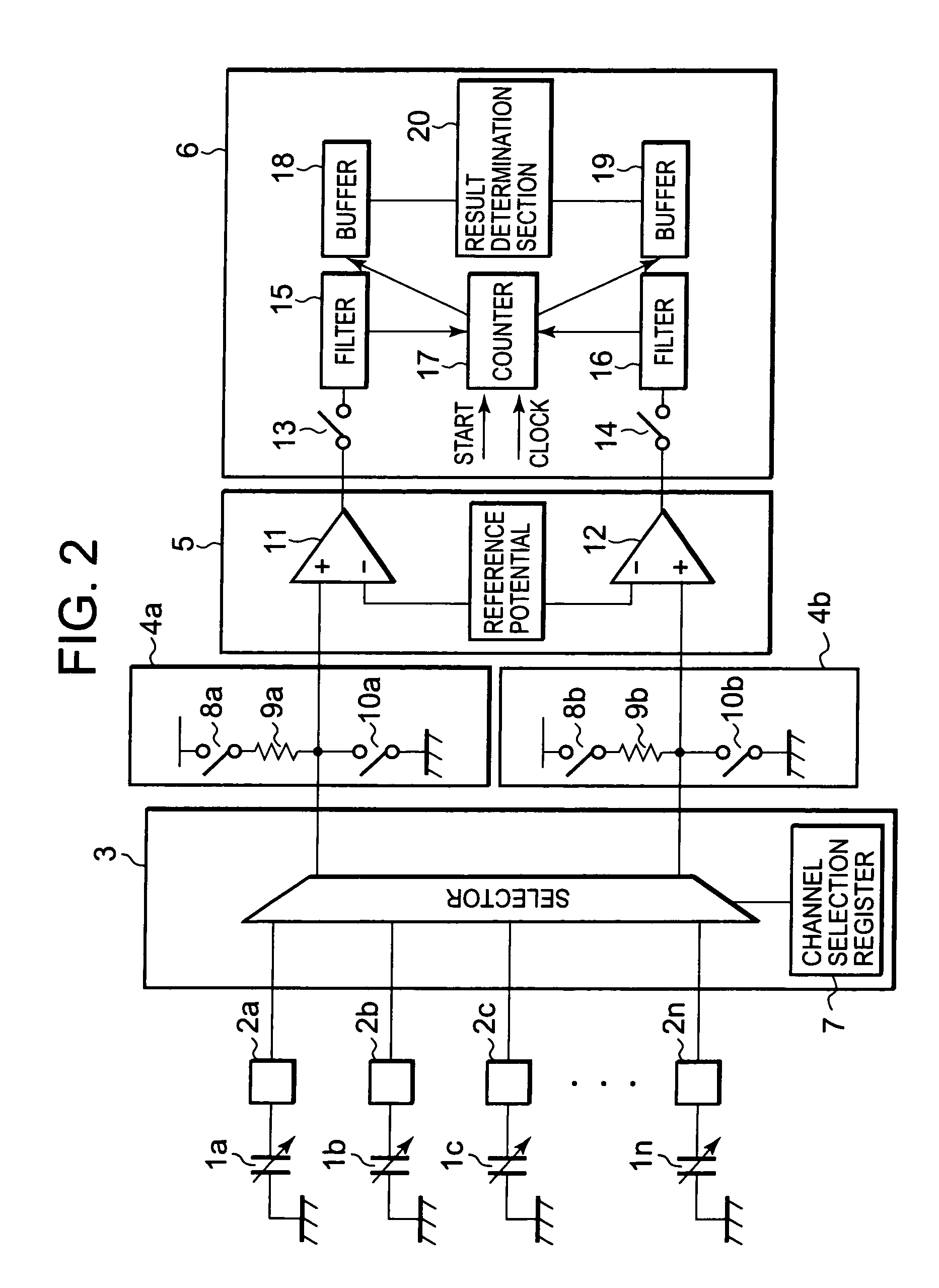Capacitive sensing device and method
a sensing device and capacitive technology, applied in the direction of pulse technique, instruments, transportation and packaging, etc., can solve problems such as power consumption, and achieve the effects of improving determination speed, reducing device power consumption, and improving determination speed
- Summary
- Abstract
- Description
- Claims
- Application Information
AI Technical Summary
Benefits of technology
Problems solved by technology
Method used
Image
Examples
first embodiment
[0027]FIG. 1 is a general explanatory diagram illustrating a concept of a capacitive sensing device according to a first embodiment of the present invention. The capacitive sensing device includes n channels (electrodes) 2a, 2b, . . . , and 2n, capacitors 1a, 1b, . . . , and 1n changed when a human body (finger) is in contact with electrodes, a selector 3, charging and discharging control sections 4a and 4b, a comparison section 5, and a determination section 6.
[0028]FIG. 2 is a detailed diagram illustrating the capacitive sensing device. The selector 3 includes a channel selection register 7 for storing a value for selecting two channels of n input channels. The charging and discharging control section 4a (4b) includes a resistor element 9a (9b) and switches 8a and 10a (8b and 10b) for connecting the capacitors 1a to 1n with a power supply potential or a ground potential through the selector 3 to charge or discharge the capacitors 1a to 1n. The comparison section 5 includes compara...
second embodiment
[0048]FIG. 7 illustrates a capacitive sensing device according to a second embodiment of the present invention. The second embodiment is different from the first embodiment in that the determination section 6 includes the counter 17, an exclusive OR (XOR) circuit 21, and latch circuits (storage sections) 22 and 23. As in the first embodiment, the capacitive sensing device may be realized using the microcomputer and the control program as illustrated in FIG. 6 even in the second embodiment.
[0049]Next, an operation of the capacitive sensing device according to the second embodiment is described with reference to FIGS. 7 to 9. Two channels (channels 2a and 2b) are selected from the n input channels by the selector 3 (Step S21). During the interval between the times t1 to t2, the switches 10a and 10b of the charging and discharging control sections 4a and 4b are kept ON (Steps S22 and S23). Then, the capacitors connected to the channels 2a and 2b are discharged.
[0050]At the time t3, the...
third embodiment
[0061]FIG. 10 illustrates a capacitive sensing device according to a third embodiment of the present invention. The third embodiment is different from the first and second embodiments in that the determination section 6 includes the counter 17, the latch circuits (storage sections) 22 and 23, and a compare register 24. As in the first and second embodiments, the capacitive sensing device may be realized using the microcomputer and the control program as illustrated in FIG. 6 even in the third embodiment.
[0062]Next, an operation of the capacitive sensing device according to the third embodiment is described with reference to FIGS. 10 to 12. Two channels (channels 2a and 2b) are selected from the n input channels by the selector 3 (Step S31). During the interval between the times t1 to t2, the switches 10a and 10b of the charging and discharging control sections 4a and 4b are kept ON (Steps S32 and S33). Then, the capacitors connected to the channels 2a and 2b are discharged.
[0063]At ...
PUM
 Login to View More
Login to View More Abstract
Description
Claims
Application Information
 Login to View More
Login to View More - R&D
- Intellectual Property
- Life Sciences
- Materials
- Tech Scout
- Unparalleled Data Quality
- Higher Quality Content
- 60% Fewer Hallucinations
Browse by: Latest US Patents, China's latest patents, Technical Efficacy Thesaurus, Application Domain, Technology Topic, Popular Technical Reports.
© 2025 PatSnap. All rights reserved.Legal|Privacy policy|Modern Slavery Act Transparency Statement|Sitemap|About US| Contact US: help@patsnap.com



